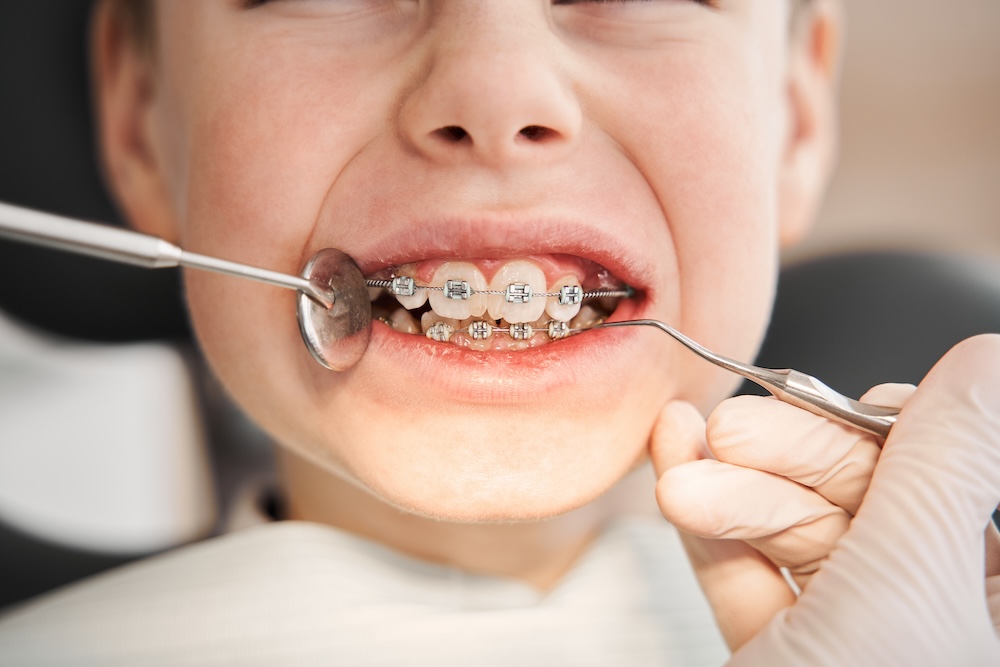
-
Posted By Dr. Maya Dental
-
-
Comments 0
Braces can be a solution for children with misaligned teeth, bite issues, or other orthodontic problems. Knowing when your child might need braces can save time and help them achieve a healthy and confident smile. Below are six key signs that indicate it might be time to visit an orthodontist.
1. Crowded or Crooked Teeth
One of the most common reasons children need braces is overcrowding or misalignment of the teeth. Crowding occurs when there is not enough space in the mouth for all the teeth to fit properly, causing them to overlap, twist, or push into each other.
Crooked teeth can impact not just the appearance of your child’s smile, but also oral hygiene. Overlapping teeth can create hard-to-reach areas, increasing the risk of cavities and gum disease. If you notice that your child’s teeth don’t appear straight, consulting with a children’s dentist or orthodontist can clarify whether braces may be needed.
2. Difficulty Chewing or Biting
Sometimes, issues with the alignment of your child’s teeth or jaws can make chewing and biting difficult. If your child complains about discomfort while eating or struggles to bite into certain foods, this could be a sign of a problem. Issues such as an overbite, underbite, crossbite, or open bite can interfere with proper chewing and digestion.
An orthodontist can assess the situation and recommend corrective measures, such as braces, to ensure your child’s bite is properly aligned.
3. Early or Late Loss of Baby Teeth
The timing of losing baby teeth can also indicate potential orthodontic issues. If your child’s baby teeth fall out much earlier or later than average, it might disrupt the proper alignment of permanent teeth as they grow in. Early loss of baby teeth can leave gaps that cause neighboring teeth to shift into positions meant for adult teeth.
Conversely, delayed loss of baby teeth can prevent permanent teeth from erupting correctly. Braces or other orthodontic interventions may be necessary to guide proper tooth development in these cases.
4. Jaw Problems and Misalignment
Pay close attention if your child experiences jaw-related issues such as clicking sounds, difficulty closing their mouth, or frequent jaw pain. These symptoms could point to misalignment of the jaw, often referred to as malocclusion.
This condition can cause difficulty in day-to-day activities like speaking or eating. Over time, untreated jaw misalignment can lead to more complex issues, including temporomandibular joint (TMJ) disorders. Orthodontists specialize in evaluating these kinds of problems and may recommend braces to help align the jaw.
5. Overbite, Underbite, or Crossbite
The alignment of your child’s bite is a crucial factor in determining whether braces are necessary. Here are some common bite problems to watch for:
Overbite: This occurs when the upper teeth excessively overlap the bottom teeth. Left untreated, an overbite can lead to tooth wear, jaw pain, or even difficulty speaking.
Underbite: This happens when the lower teeth protrude beyond the upper teeth, which can make chewing and speaking challenging.
Crossbite: A crossbite is when some of the upper teeth sit inside the lower teeth instead of outside. Crossbites can lead to uneven wear on teeth and jaw discomfort.
Any of these bite issues can benefit from braces as a corrective treatment, reducing discomfort and ensuring proper functionality.
6. Difficulty in Speech or Pronunciation
In some cases, orthodontic treatment may also be recommended for those who struggle with speech or pronunciation. Misalignment of the teeth and jaw can affect the way sounds are formed and how words are pronounced. This can lead to difficulty communicating effectively, which can have a significant impact on a child’s self-esteem and social interactions.
Braces can help align the teeth and jaws, improving speech and pronunciation for those who struggle with these issues.
Early Detection Matters
Orthodontic problems are often easier and quicker to correct when they’re identified early. Many orthodontists recommend that children have their first consultation by the age of seven, even if there are no obvious issues. At this stage, an orthodontist can assess the development of your child’s teeth and jaw, identify potential problems, and create a treatment plan if needed. Early detection can often prevent more serious orthodontic issues from developing later.
What to Expect During a Consultation
If you suspect your child might need braces, scheduling a consultation with an orthodontist is the first step. During the appointment, the orthodontist will examine your child’s teeth, jaws, and overall oral health. X-rays and impressions of the teeth may be taken to gain a clearer understanding of the situation.
After the evaluation, the orthodontist will discuss whether braces are necessary and, if so, outline the recommended treatment plan. They will also explain the different types of braces available, such as traditional metal braces, clear aligners, or ceramic braces, and help you choose the best option for your child’s needs.
Recognizing the signs that your child may need braces can significantly affect their long-term oral health. From crowded teeth to bite misalignments, addressing these issues early can give your child the best chance for a healthy and confident smile. If you notice any of the signs mentioned above, don’t hesitate to consult with a children’s dentist in Dubai at Dr. Maya Dental Centre to determine the best course of action. Taking proactive steps now can help prevent complications and set your child on the path toward a bright and healthy smile.


